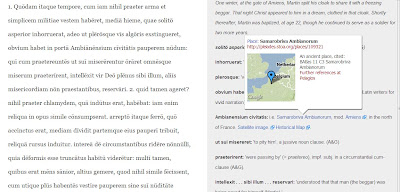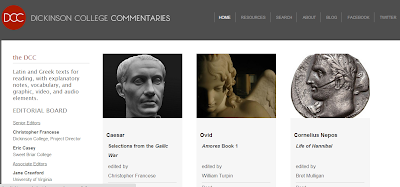DCC explores a model of textual commentary that tries to take full advantage of the digital medium, harnessing the best of traditional philological, historical, and archaeological scholarship, and focusing on the user experience in a way to enhance reading, rather than just searching. We’re not really a database, but a reading environment, so we try not to bury the user in information, but to offer scholarly guidance informed by teaching experience. We also have some limitations financially and institutionally. We are lucky to have an endowment at the Department of Classical Studies at Dickinson, on which we can draw to hire undergraduate students. And we have a strong support system in the Academic Technology unit at Dickinson, where Ryan Burke built the structure of our site in Drupal, and helps to maintain and improve it. But we have no graduate students, no dedicated programmers or web developers, and no full time staff. I teach a full load at Dickinson and do this in my spare time, as it were, with help of a number of colleagues at other institutions who are on our editorial board. This is all to say that I have to be careful about not getting in over my head when it comes to site maintenance. I value user functionality and solid content above all, but simplicity runs a very close third.
Pelagios, with its machine linking of places mentioned in our commentaries to the unique place identifiers in Pleiades, delivers simplicity itself. On our end what needed to be done was to create a single file that listed all of our geographical annotations, with their locations (urls). We already had Google Earth maps made in summer 2012 by Dickinson student Merri Wilson, that contained placemarks with all places mentioned in two of the existing commentaries, each placemark annotated with Pleiades URIs (unique identifiers). A third Google Earth map, for Caesar’s Gallic War, did not have the Pleiades URIs, and all the linkages in the other two commentaries (Sulpicius Severus’ Life of St. Martin and Book 1 of Ovid’s Amores) had to be checked for errors. Archaeology and Classics major Dan Plekhov was perfect for this job, which required a good knowledge of ancient geography, Latin, Greek, and solid research skills. He worked in Carlisle for 8 weeks in the summer of 2013, with approximately two weeks devoted to this aspect of the project.
Meanwhile, computer science major Qingyu Wang investigated the .RDF format we were to use for the comprehensive file, and the very specific formatting required by Pelagios. This is not exactly the kind of thing computer science majors do all day, but she taught herself the skills she needed to complete the work, spending about a week on it all told. She was aided by good advice from Sebastian Heath at New York University, and Rainer Simon of Pelagios. We had to invent a human-readable code for our specific type of annotations—so we could keep track of things and every annotation would have a unique designation—then put all that into a format that Pelagios could deal with. My role was deciding on concise but informative conventions that fit our material. Once we figured all that out, Qingyu created the .RDF file that specifies the linkages between a unique ancient place as referred to in Pleiades, with a specific annotation on a page of our site. Now, when you go to that place in Pleiades (Gallia, for instance), under "Related Content from Pelagios" you will see "Pleiades urls Dickinson College Commentaries." So someone exploring Gaul could now go straight to DCC, read Caesar’s account, or watch our little video of the famous opening paragraph of the BG.
Here are some examples of the lists of references we adapted from the Pelagios template. The first is a reference to the Alps in Sulpicius Severus' Life of St. Martin, section 5.
<rdf:Description xmlns:rdf="http://www.w3.org/1999/02/22-rdf-syntax-ns#" xmlns:h="http://www.w3.org/1999/xhtml" xmlns:rdfs="http://www.w3.org/2000/01/rdf-schema#" xmlns:oac="http://www.openannotation.org/ns/" xmlns:dcterms="http://purl.org/dc/terms/" rdf:ID="sulpicsev-martin-5.4-alpes">
<rdf:type rdf:resource="http://www.openannotation.org/ns/Annotation"/>
<oac:hasBody rdf:resource="http://pleiades.stoa.org/places/783"/>
<oac:hasTarget rdf:resource="http://dcc.dickinson.edu/sulpicius-severus/section-5"/>
<dcterms:creator rdf:resource="http://dcc.dickinson.edu/"/>
<dcterms:title>"Sulpicius Severus, Life of St. Martin 5.4"</dcterms:title>
</rdf:Description>
The Gallic tribe the Boii in Caesar, Gallic War 1.5:
<rdf:Description xmlns:rdf="http://www.w3.org/1999/02/22-rdf-syntax-ns#" xmlns:h="http://www.w3.org/1999/xhtml" xmlns:rdfs="http://www.w3.org/2000/01/rdf-schema#" xmlns:oac="http://www.openannotation.org/ns/" xmlns:dcterms="http://purl.org/dc/terms/" rdf:ID="caesar-bg-1.5-boii">
<rdf:type rdf:resource="http://www.openannotation.org/ns/Annotation"/>
<oac:hasBody rdf:resource="http://pleiades.stoa.org/places/197173"/>
<oac:hasTarget rdf:resource="http://dcc.dickinson.edu/caesar/book-1/chapter-1-5"/>
<dcterms:creator rdf:resource="http://dcc.dickinson.edu/"/>
<dcterms:title>Julius Caesar, Gallic War 1.5</dcterms:title>
</rdf:Description>
Mt. Olympus in Ovid, Amores 1.2.39:
<rdf:Description xmlns:rdf="http://www.w3.org/1999/02/22-rdf-syntax-ns#" xmlns:h="http://www.w3.org/1999/xhtml" xmlns:rdfs="http://www.w3.org/2000/01/rdf-schema#" xmlns:oac="http://www.openannotation.org/ns/" xmlns:dcterms="http://purl.org/dc/terms/" rdf:ID="ovid-amores-1.2.39-olympusmons">
<rdf:type rdf:resource="http://www.openannotation.org/ns/Annotation"/>
<oac:hasBody rdf:resource="http://pleiades.stoa.org/places/491677"/>
<oac:hasTarget rdf:resource="http://dcc.dickinson.edu/ovid-amores/amores-1-2"/>
<dcterms:creator rdf:resource="http://dcc.dickinson.edu/"/>
<dcterms:title>"Ovid, Amores 1.2.39"</dcterms:title>
</rdf:Description>
Our full .rdf file is available here.
Another aspect of that process, in a sense the reverse of it, was the automatic channeling of data from Pleiades into DCC, via the addition of thumbnail pop-ups on the names of places mentioned in the notes fields. As of this summer, when you mouse over such a linked place name in DCC, a thumbnail with a small map pops up, with the link to Pleiades.

The beauty of this is that one does not have to navigate away from the text to get an idea of where roughly the place is; but at the same time, Pleiades is only a click way. Qingyu and Ryan Burke made this happen, using a bit of css code created by Sebastian Heath for use in his ISAW papers. One nagging issue is that when viewed on an iPad, the pop-ups do not go away, and one must reload the page to get rid of them. But I view this is a superb use of the digital medium to enhance the reading experience. Geographical knowledge is delivered on time, as needed, unobtrusively, right there beside the text, in way simply impossible in print. And all that is required, once the css code is in place, is to create the normal html link in the Drupal editor.
I’m here at a liberal arts college doing digital humanities at a fairly small scale, compared to what’s going on at large research universities, or at a well-funded outfit like the Perseus Project. Small size has certain advantages, I suppose, but the biggest danger is probably isolation. On an organizational level I try to avoid that by reaching out to colleagues at other institutions and getting them involved, as the Bryn Mawr Classical Review has done so successfully. But Pelagios offers DCC and projects like it an equally potent way to combat isolation, by allowing our small project to make a contribution to the much larger world of linked geographical data. Maybe someday there will be a similar infrastructure of sharing linked data about ancient persons, texts, and material objects as well, and I’d like to be there adding to it.
Chris Francese (francese@dickinson.edu)


No comments:
Post a Comment